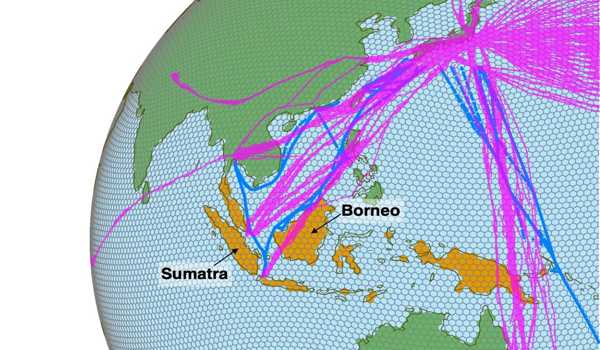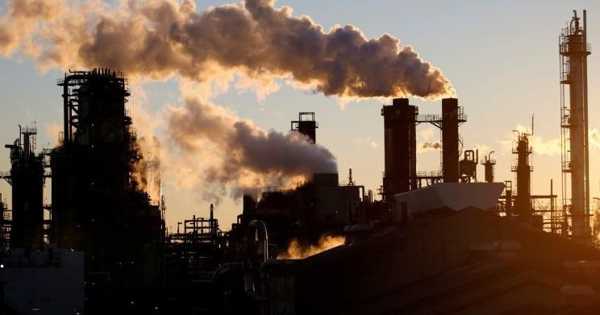Tropical deforestation accounts for roughly 20% of annual global greenhouse gas (GHG) emissions, and it must be reduced if dangerous climate change is to be avoided. China and the United States are the world’s top two emitters, but Indonesia and Brazil are third and fourth, with deforestation accounting for 80% and 70% of their emissions, respectively. Slowing or halting deforestation is a short-term, low-cost option for significantly reducing global emissions, with extraordinary additional benefits for biological diversity and sustainable development in tropical countries.
Massive biomass burning events occurred in Equatorial Asia in 2015, releasing a large amount of carbon into the atmosphere, the signals of which were captured by in-flight high-precision measurements on commercial passenger aircraft and a cargo ship. Based on those observations, a simulation-based analysis estimated fire-induced carbon emissions to be 273 Tg C in September and October of 2015.
Due to the severe drought conditions caused by the extreme El Nio and a positive anomaly of the Indian Ocean dipole, Equatorial Asia, which includes Indonesia, Malaysia, Papua New Guinea, and surrounding areas, experienced devastating biomass burning in 2015. This biomass burning released a significant amount of carbon into the atmosphere, primarily in the form of carbon dioxide (CO2).
Equatorial Asia has very few ground-based stations that observe CO2 and other related atmospheric constitutents. This biomass burning emitted a significant amount of carbon, mainly in the form of carbon dioxide, into the atmosphere.
There are very few ground-based stations in Equatorial Asia that monitor CO2 and other atmospheric constituents. Meanwhile, a few satellites could measure atmospheric CO2; however, their data was limited and subject to errors due to cumulus clouds common in the tropics and smoke from biomass burning.
To estimate the fire-induced carbon emissions from Equatorial Asia in 2015, a research team from Japan’s National Institute for Environmental Studies (NIES) and Meteorological Research Institute (MRI) collected high-precision observations onboard commercial passenger aircraft and a cargo ship traveling through Equatorial Asia. These observations are unique in that they are made on a moving platform, allowing three-dimensional gradients of atmospheric CO2 concentrations to be captured. The NIES-MRI collaborative research project CONTRAIL conducts the aircraft observations. The shipboard observations are operated by NIES as a part of the Global Environmental Monitoring project.

Using these aircraft and ship observations, the team conducted an inverse analysis based on numerical simulations of atmospheric transport and estimated that the amount of carbon emitted from Equatorial Asia in September-October 2015 was 273 Tg C. The simulation-based analysis’s validity was carefully evaluated by comparing the simulated atmospheric concentrations with those of the observations, not only for CO2 but also for carbon monoxide, which was used as a proxy for combustion sources.
In fact, this estimate is slightly lower than previous studies’ estimates. However, nearly 300 Tg C emissions in only two months are exceptional because they are comparable to Japan’s annual CO2 emissions.
“Our study is the first to use in-situ high-precision observations to estimate fire-induced emissions from Equatorial Asia in 2015, contributing to a better understanding of biomass burning in this region. It is thought that biomass burning in this area is dominated by fires in peatland, which has an unusually high carbon density. Despite its small terrestrial coverage, Equatorial Asia plays an important role in the global carbon cycle due to its significant amount of peatland”, According to the study’s lead author, Yosuke Niwa (NIES & MRI). “Peatland develops over many thousands of years.
As a result, restoring carbon in burned peatland is difficult. Meanwhile, forests may be able to recover by absorbing CO2 from the atmosphere. However, if the burned land was converted to a crop field or if fires occurred frequently in the same location, such CO2 uptake by forest regrowth would be insufficient”, said Akihiko Ito (NIES), a study co-author who works on terrestrial biosphere simulations. It is critical to continue monitoring CO2 concentrations in the atmosphere.
Despite the difficult circumstances caused by the COVID-19 pandemic, these observations are continuing thanks to the tremendous efforts of the commercial companies that operate the aircraft and ship. “We will continue these observations for many years to come in order to provide useful information for mitigating climate change,” said Toshinobu Machida (NIES), the project’s leader.
















